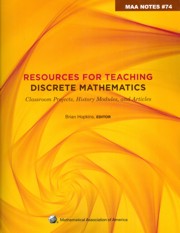Book contents
- Frontmatter
- Introduction
- Dedication
- Contents
- I Classroom-tested Projects
- The Game of “Take Away”
- Pile Splitting Problem: Introducing Strong Induction
- Generalizing Pascal: The Euler Triangles
- Coloring and Counting Rectangles on the Board
- Fun and Games with Squares and Planes
- Exploring Recursion with the Josephus Problem: (Or how to play “One Potato, Two Potato” for keeps)
- Using Trains to Model Recurrence Relations
- Codon Classes
- How to change coins, M&M's, or chicken nuggets: The linear Diophantine problem of Frobenius
- Calculator Activities for a Discrete Mathematics Course
- Bulgarian solitaire
- Can you make the geodesic dome?
- Exploring Polyhedra and Discovering Euler's Formula
- Further Explorations with the Towers of Hanoi
- The Two Color Theorem
- Counting Perfect Matchings and Benzenoids
- Exploring Data Compression via Binary Trees
- A Problem in Typography
- Graph Complexity
- II Historical Projects in Discrete Mathematics and Computer Science
- III Articles Extending Discrete Mathematics Content
- IV Articles on Discrete Mathematics Pedagogy
- About the Editor
Calculator Activities for a Discrete Mathematics Course
from I - Classroom-tested Projects
- Frontmatter
- Introduction
- Dedication
- Contents
- I Classroom-tested Projects
- The Game of “Take Away”
- Pile Splitting Problem: Introducing Strong Induction
- Generalizing Pascal: The Euler Triangles
- Coloring and Counting Rectangles on the Board
- Fun and Games with Squares and Planes
- Exploring Recursion with the Josephus Problem: (Or how to play “One Potato, Two Potato” for keeps)
- Using Trains to Model Recurrence Relations
- Codon Classes
- How to change coins, M&M's, or chicken nuggets: The linear Diophantine problem of Frobenius
- Calculator Activities for a Discrete Mathematics Course
- Bulgarian solitaire
- Can you make the geodesic dome?
- Exploring Polyhedra and Discovering Euler's Formula
- Further Explorations with the Towers of Hanoi
- The Two Color Theorem
- Counting Perfect Matchings and Benzenoids
- Exploring Data Compression via Binary Trees
- A Problem in Typography
- Graph Complexity
- II Historical Projects in Discrete Mathematics and Computer Science
- III Articles Extending Discrete Mathematics Content
- IV Articles on Discrete Mathematics Pedagogy
- About the Editor
Summary
Summary
Using the symbolic capabilities of the TI-89 calculator can enhance discrete mathematics. Our mathematics and computer science majors take discrete mathematics as a post calculus course. Typical students come to the first class with their TI-89 in hand, both wanting and expecting to be able to use it. In response to their expectations we have developed a series of calculator activities which can be used to supplement and enhance some of the topics of discrete mathematics. They are designed to improve the basic understanding of course content, and to provide guidance for students as they transition from the concrete to the abstract.
Many of our students want the calculator to give them all of the answers. Their first experiences with the calculator reinforce this idea. As they advance through the curriculum, they begin to experience situations in which the calculator does not return the anticipated result. Our task is to take students from the level of dependency to the place where they can use the calculator as an analytical tool. As instructors, one way in which we can accomplish this purpose is by providing calculator activities which ask questions requiring interpretation of the output. The calculator cannot answer why, nor does it flag an erroneous answer.
Developing calculator skills is a direct way to improve analytical thinking. The calculator allows students to gain a sense of what is happening in a problem.
- Type
- Chapter
- Information
- Resources for Teaching Discrete MathematicsClassroom Projects, History Modules, and Articles, pp. 75 - 82Publisher: Mathematical Association of AmericaPrint publication year: 2009



